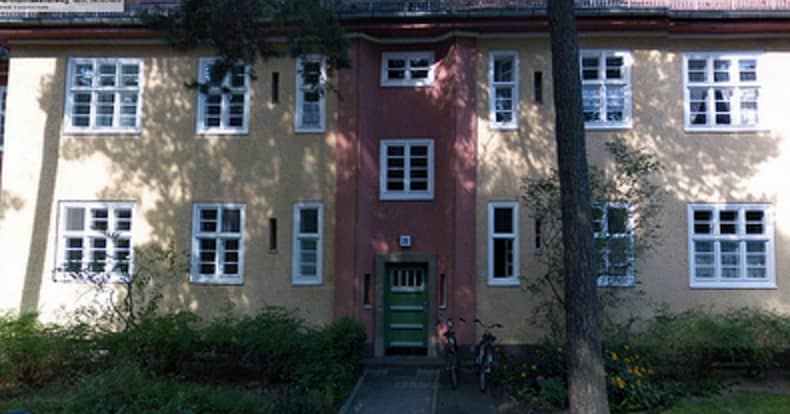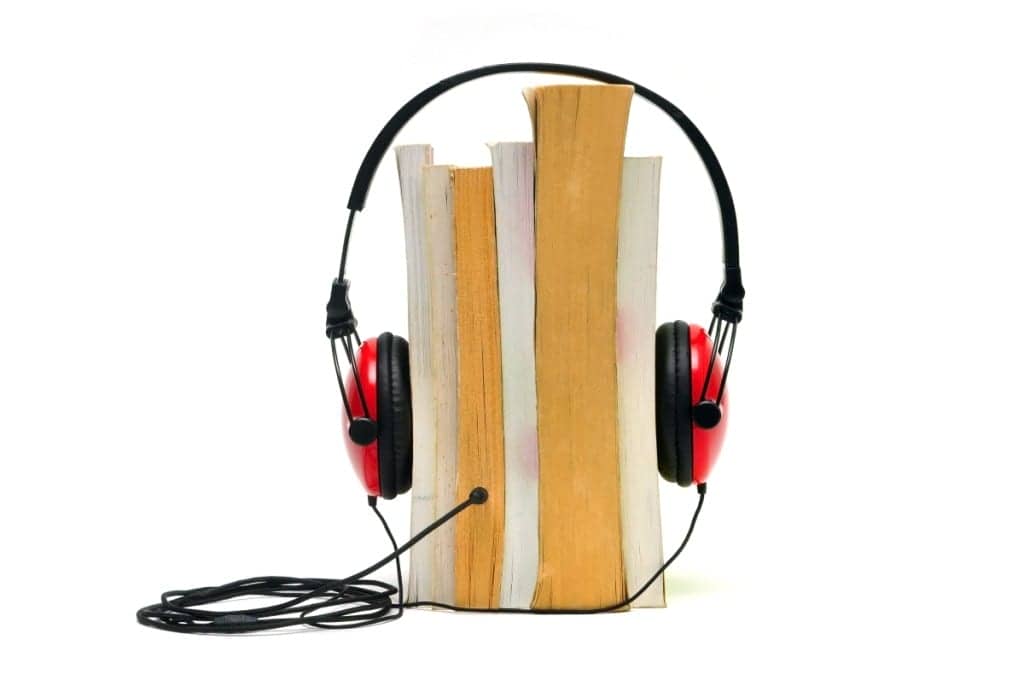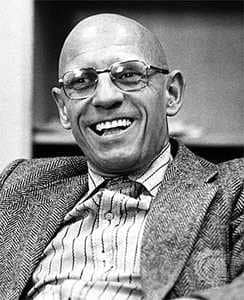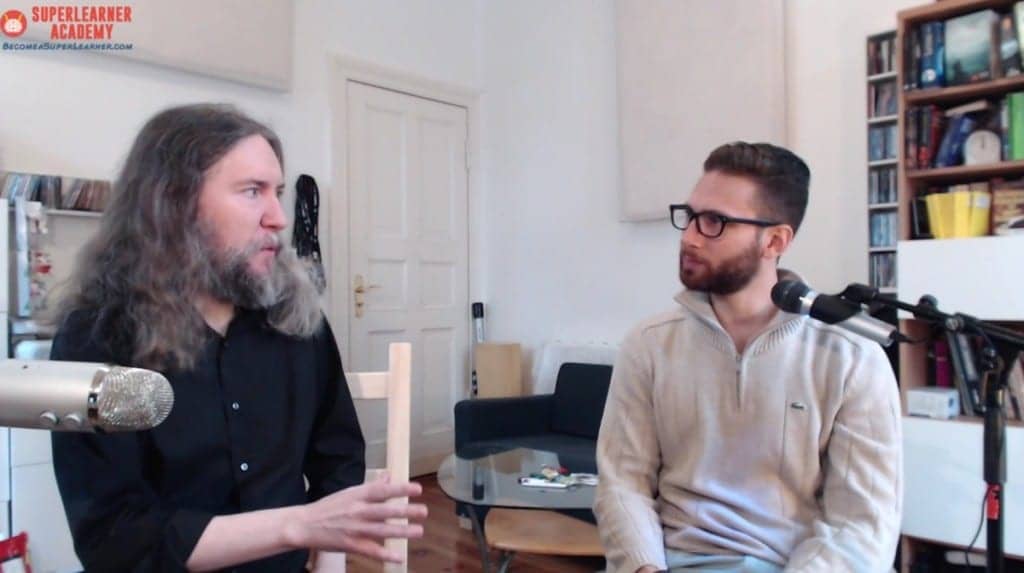Podcast: Download
Subscribe: Apple Podcasts | RSS
I’ll never forget the day I made the most important discovery of my life. A discovery that would also prove important for thousands of language learners and students of various topics around the world.

Here’s what happened:
I was on my porch down in Zehlendorf. (It’s really too bad about Zehlendorf …)
I really miss that part of Berlin. I used to walk to the nearby lake Krumme Lanke and through a wooded area leading to the stores and the M48 bus I often took to Potsdamer Platz.
I went there so I could watch movies for my work.
Yes, watch movies. I was a Film Studies professor back then. Greatest job in the world – if you can get it.
And If You Can Keep It!
Anyhow, I was on the porch studying German and nearly tearing out my hair with frustration. No matter what I did, the German vocabulary wouldn’t stick in my mind.
Worse, the flashcard software I’d been using bored me to tears. I’ve never found anything more painful than banging foreign language vocabulary repetitively against my eyes in the vain hope that I would somehow magically remember the abstract and mysterious words.
In all fairness, some people can tolerate rote learning. In fact, there’s research suggesting that polyglots get great value from hard repetition. This happens primarily because they’ve trained themselves to be really good at it.
But Let’s Be Real
Most people do not want to be polyglots. Most people would be happy just to get halfway decent in one language, not several.
In fact, most people would be overjoyed just to get a couple of hundred words in their long term memory.
And most people would be ecstatic if they could turn those words into basic conversational fluency. All you need is about 800-1200 for that, plus a touch of understanding the grammar.

So there I was with a fat dictionary pumping words into the spaced-repetition software I loathed like the plague.
I sure loved that dictionary, though. What a glorious thing, all thick and yellow.
Heavy too, almost as heavy as a brick. But that didn’t stop me from carrying this German-only (or monolingual) dictionary everywhere.
And That’s When It Hit Me!
With a bit of summer wind on my face, I asked myself a fundamental question:
Why on earth wasn’t I using memory techniques to help me learn German?
Seriously. They sometimes say that Ph.D. stands for “piled higher and deeper,” but Mann O Mann (as the Germans say), was I ever mystified.
You see, following a terrible and nearly suicidal depression that almost forced me out of grad school, I discovered memory techniques almost by accident. I was avoiding the looming field exams and dissertation defense by learning magic tricks.
Of course, procrastinating on my studies only made my depression worse …
But it’s at least a good thing that I was doing something constructive. I thought of my magic practice as developing a kind of “emergency paycheck,” because I was certain at that time I was going to wind up on the streets with nothing more to do than entertain people and pass around my hat.
And I suppose that would have been fun for awhile. Studying card magic was certainly better than jumping off a bridge, which the mounting pressure and the teeth of my depression were forcing me to consider.
Worse, if you’ve ever experienced the horrors of manic-depression in full swing, you know the impulses involved. They are sick and sweet and jump out at you from nowhere. It’s terrible too because once the urges pounce, they can keep trouncing on you for days and days on end.
The most sinister part of the situation was that I couldn’t concentrate or read. It always felt like my eyes were slipping off the page. And when I could read for brief periods of time, I always wound up forgetting everything.
And that made me frustrated and even angry. Magic was my only relief.
And it was easy to study too because you can buy a lot of training in card and coin magic on DVD. I didn’t have a whole lot of money at the time, but it sure was worth it.
Especially when I came across the process that would save my life. I’m talking about the “Holy Grail” of all card tricks: The Memorized Deck.
There’s a ton of effects you can create with a memorized deck. The only difference is …
They Aren’t Effects! They’re Based On Real Magic …
… Or at least, the closest thing to real magic that exists. The ability to go through 52 cards, looking at each only once and being able to recall the entire order backward and forward …
This ability is a complete miracle.
So I bought a book on the topic and an audio program that included a section on card memorization. It would be years before I read the book, but my hungry ears gobbled up the audio like peasants on bread during a famine.
And what I heard nearly made my brain explode.
It’s true. I understood the procedures immediately. It’s shocking how simple it is, and yet …
… I was skeptical. How on earth was I going to put these techniques into action when I could barely concentrate on a book?
Not only that, but playing cards are essentially a kind of book, only they are made up of totally abstract and fragmented sentences and chapters. And the pages can be endlessly recombined.
But even so, I gave the technique a try.
What happened totally blew me away.
Why?
Because 15 minutes after learning the technique, I had memorized my first deck of shuffled cards.
I couldn’t believe it.
In fact, to this day I’m still in awe. And the reason I work so hard to promote memory techniques to people around the world is precisely because that awe remains.
And it grows and grows the more I hear from people who have read one of my books or taken one of my video courses.
They All Have One Special Characteristic In Common …
They, like me, learned the methods and took action. They experimented. They memorized vocabulary using the tools of the Magnetic Memory Method and they got results.
And then they repeated what they learned and got even more results. And those results led to even higher payoffs because things just keep getting better and better the more you use mnemonics as part of your learning.
Anyhow, as soon as I realized what I had done with the playing cards, I instantly saw how I could apply these techniques to learning and memorizing the 250+ books I needed to cover for my field exams. (500 when you add on dissertation research…)
These exams are mean and nasty affairs. Seven professors sit around a table and drill you with questions for nearly two hours. They’re very protective of the university Ivory Tower, so they do everything they can to keep you out.
The hostility makes the process of sitting for those exams frightening an stressful in every possible way.
And frankly, most people never make it. I don’t know what the figures are now, but back then, the graduation rate from Ph.D. programs in Canada was a mere 13%.
In other words, out of every 100 people who enter grad school, 87 walk away without a degree.
But I wasn’t one of those who left the hallowed halls empty-handed. And it’s all because I took action and used the memory techniques I’d learned on that magical day during the depths of my nearly suicidal depression.
Of course, it’s not as if my studies were suddenly free from challenges.
Far From It
The memory techniques boosted my confidence and this gave me increased clarity. But I still struggled to read with the amount of focus needed to even discover and isolate the information I wanted to memorize. I also didn’t have Atomic Habits like the kind I’ve since learned from James Clear.
So what I wound up doing was to read the books out loud. Unlike the memory audio program I had no problem following, the philosophy and history books I was reading had no audio editions.
Worse, they were so dense and so obscure … It was often like pulling teeth just to get through them.
But by reading out loud to maintain my concentration and then listening to my narrations, I could finally concentrate.
And then I would write down the key points and facts from the books on index cards.
Next, I would order the index cards in particular ways to aid the memorization of them into the Memory Palaces I’d created.
(Here are 5 Memory Palace examples if you need them.)
Following that, I memorized the information on the cards. Kind of like memorizing a deck of playing cards, only in this case you’re not entertaining audiences but rather earning a degree.
But there was another level of difficulty.
The memory techniques and especially the Memory Palaces I was using at the time were far from foolproof.
And I Made A Lot Of Mistakes
You see, the techniques I had learned were actually kind of pedestrian. They weren’t made for higher levels of learning. And they certainly weren’t designed for language study.
So what I did was to develop completely new approaches to the memory techniques. I was still learning and memorizing information very well, but I knew I could do better.
Above all, I knew that my Memory Palaces could be much more precise. So I found better ways to begin the journeys through them. I discovered principles that reduced the errors many people make with mnemonics and massively reduced the cognitive load extensive learning places on the mind.
And the more I worked at it, the more streamlined the techniques became. Before I knew it, I had zoomed through most of the books and was ready to sit for my exams. (These days, I also use mind mapping based on this Tony Buzan methodology.)
I had also finally landed on a feasible dissertation topic. And even though I still felt physically terrible and the mental illness remains to this day …
I Was Sitting On Top Of The World
I marched into those exams brimming with confidence and aced them.
In fact, when my final dissertation defense concluded and I was called “Dr. Metivier” for the very first time, the top examiner who had come up to Canada from the United States told me something I’ll never forget.
“Most people freeze up,” he said. “Some of them even break into tears. But you …
… the only person cooler than you is Miles Davis.”
I guess what he meant is that I was calm, collected and cool in the sense of being unshakable. And trust me, each and every one of the professors surrounding me at that table on the second floor of the Vanier building on the campus of York University in Toronto did all they could to shake me up.
But none of them could, not even the one hellbent on failing me.
Why?
Because I knew my stuff and could remember it.
All Of It
And when they awarded my degree, they even added a special comment on the form that I had presented my knowledge with originality and audacity.
I take that to mean that I did it all with nerves of steel, total confidence and the ability to create new knowledge, not just parrot what I’d memorized.
And that’s what the Magnetic Memory Method is all about: Creating knowledge while also being able to repeat information verbatim. Or in the case of memorizing vocabulary, being able to create unique and meaningful sentences.
But don’t get me wrong.
In some cases, being a parrot isn’t a bad thing.
Not A Bad Thing At All
But let’s flash forward a couple of years.
There I was on the porch. Stupidly I’d sat through six months of a German language course after landing a research and teaching grant at a university there.
Looking back, I still can’t believe it. But in all fairness, I had already used my memory to get my Ph.D. But researching and teaching didn’t require them in quite the same way. I used mnemonics only to memorize the names of my students and the basic architecture of my lectures.
But on that porch, I realized that I could have been using memory techniques all along to memorize German vocabulary. The only question now was …
How?
When I thought back to what I’d done during my graduate years, it all fell into place.
You see, when organizing the knowledge I needed to know in order to memorize the works of philosophers and literary or film theorists great and small, I had created at least one Memory Palace for each, sometimes up to five.
In many cases, the Memory Palaces weren’t so much centered on the career of a philosopher, but on a single book. For example, for Aristotle I concentrated only on memorizing the major details of The Nicomachean Ethics. But as for the rest of his cannon, I’m a sitting duck in water.
Michel Foucault, on the other hand, had five Memory Palaces, four for individual books he’d written and one for facts about his life and how it intersected with important moments in his Zeitgeist.
Regardless of having one Memory Palace or five per philosopher, in each I got some kind of picture in my mind of what that person looks like. In the case of Aristotle, I had only paintings to work with. With Foucault, I could look at oodles of photographs.
Then, using a well-formed Memory Palace that obeys the principles of what would eventually become the Magnetic Memory Method, I followed these philosophers along carefully constructed journeys. At one point, for example, Aristotle fistfights with the notorious serial killer John Wayne Gacy. Foucault, known for his sexual escapades, got into some situations rather X-rated to at present mention.
I would eventually come to call these Magnetic little puppets of mine, “Bridging Figures.”
Why?
Because by following them around in my imagination, they “bridged the gap” between Memory Palace stations and engaged in behaviors that quickly and efficiently reminded me of the key points I needed to know. After that, it was just a matter of rehearsing the show a few times and writing out what I’d learned in summary format to ease the information into long-term memory.
As one commentator on a Magnetic Memory Method YouTube video puts it regarding my approach to memory techniques and mnemonics overall, it’s all …
Easy Peasy Lemon Squeezy
Lemon squeezy, indeed. It also works for heavier material, like memorizing concepts too:
Thinking about that practice and its tremendous power, I clearly saw that the same approach readily applied to German vocabulary. Abraham Lincoln helped me connect “ab” words in an “A” Memory Palace.
To give another example, Einstein took over the show in an imaginary reconstruction of my brother’s home.
Even more interesting, real people proved useful too.
For example, my ex-wife’s good friend Vera war sehr verantwortlich when it came to stuffing “ver” words into a very special Memory Palace that happened to be her home in Brooklyn. I had only visited the place once, but due to the mind’s uncanny ability to absorb the details of a building on autopilot, I used its rooms and hallways to great effect before moving to my old girlfriend Vicki’s home and on and on and on.
Nifty, Isn’t It?
You bet it is. And before I knew it, the fruitless hours spent on index cards and writing words out by hand became a thing if the past. I deleted every trace of the spaced-repetition software clogging my laptop and honored instead the unparalleled abilities of a well-trained memory.
Thousands of books and over a dozen video courses and public appearances later, the ancient art of memory finally had an innovation for one of its toughest opponents: language learning.
There had been other attempts. Harry Lorayne and Jerry Lucas devote three pages to memorizing vocabulary in The Memory Book. In Memo, Oddbjorn By talks about organizing a city into three parts to help organize gendered nouns, an idea he may have found in Host Von Romberch, who was a contemporary of the great mnemonist Matteo Ricci.
But none of these approaches had the rigor needed to memorize vocabulary en masse. Harry Lorayne is no fan of Memory Palaces and mnemonists like Dave Farrow use them sparingly.
Nothing Wrong With That
But for so many people like myself, pegs and linking do little or nothing. Without a track upon which to lay the associative-imagery, the choo-choo train of the mind has to grasp after ghostly images popped willy-nilly into the void, connected only by abstract relationships between silly images.
But a Bridging Figure moving along a Memory Palace journey matches two extremely concrete elements that are easy to follow. The Memory Palace serves as the rails, beautifully fixed in place. The Bridging Figure is the train conductor who stops at the stations and lets you decode the associative-imagery.
It’s simple, elegant and fun.
So Much Fun
Of course, it would be years later before I told anyone about this revelation. When I finally did release How to Learn and Memorize German Vocabulary following a mysterious and strange set of tumultuous adventures ranging from divorce to the biggest dental nightmare of my life, many people instantly got it. They went on to collectively memorize thousand of words and experience unheard of boosts in fluency.
But others didn’t get it. They cursed at my book and the books to come, calling the Magnetic Memory Method impractical, impossible and insane.
Others called me a scammer and compared me to Kevin Trudeau, a memory trainer who had broken the law by making dietary claims. What his health niche crimes have to do with his memory training, I’ll never know, but one thing will remain eternally clear: haters gonna hate.
The critics and naysayers aside, I focused all of my attention on helping the dozens of people who emailed me their questions. I spent hours clarifying the technique on an individual basis. And to be perfectly honest, I loved each and every minute.
But it soon became impractical to spend the better part of each day sharing clarifications to one person at a time. It’s the Information era after all. So I started gathering email addresses and emailed the answers to every one interested enough to subscribe.
Soon, ever more questions started rolling in. And new subscribers asked me how they could get their hands on all the emails they’d missed.
More than a hundred requests later, I created the Magnetic Memory Method Newsletter. At the end of each month, I gathered the emails I was sending once a day into a Kindle book and put them up on Amazon. Although these never became Bestseller like my other books, they have become the stuff of legend. Not a day passes when someone doesn’t ask to be subscribed to the MMM Newsletter or get the entire collection.
I’ve put ten of them together so far, totaling over 1000 pages of the deepest investigations into the art of memory on the planet. Some people have called me the Simonides of the 21st century. Others think I’m the reincarnation of Giordano Bruno (probably because of my Heavy Metal/Stoner Rock look and sometimes stubborn and insistent ways).
But to quote the late, great master of copywriting Gary Halbert:
“Whatever.”
The truth is, I’m probably best described as a Stoic language learner.
To elaborate on that point, one day I will have to put together the mounds of other correspondence with readers that I’ve never published. I expect that this eventual set of documents will amount to 10,000 or more pages of material, writing that some people will undoubtedly gobble up and put to immediate use in their personal memory practice.
But for now, my focus is on the Magnetic Memory Method Podcast and video channel, and developing projects like this analysis of The Art of Memory:
As I develop this project devoted to mental literacy for all people, I’ll keep creating second editions of the existing vocabulary books. After all, I now know so much about why people struggle with the MMM that it behooved me to incorporate it all into the first editions.
And now I’m excited to release the second edition of How to Learn and Memorize German Vocabulary. This new and revised edition includes:
* New illustrations of how to create a well-constructed Memory Palace so that you can see the principles right before your very eyes and model them.
* Drawings of a few pieces of associative-imagery so that you really understand how you can instantly memorize the sound and meaning of a word in just a minute or two.
* A lengthy list of suggested German words you will want to learn so that you aren’t stumbling around blind wondering what you should memorize.
* Notes on memorizing grammar principles and phrases so that you can speak sentences instead of just words. (Though the emphasis is on words because you can’t form sentences without them.)
* An expended discussion of Recall Rehearsal so that you know exactly how to get the words and phrases into long-term memory.
* A mega-conclusion that covers every possible question you may have so that no stone is left unturned, and you know exactly what to do to memorize hundreds of vocabulary words a week.
And make no mistake …
This Stuff Works
I heard a few months back from one person that he learned 1000 words in 6 weeks.
Just imagine what having that ability could do for you.
And even if you’re not learning German, the principles apply to any language.
So if this book is something for you, grab it here in its Enhanced Ebook form.
Let me know that you saw this page and I’ll send you a bonus recording with memory expert Jonathan Levi of SuperLearner.
In this training, we go into detail about the misconceptions and problems people have with creating Memory Palaces. It’s all in the book, of course.
But sometimes having a “student advocate” ask me questions live can make all the difference in the world. Plus, Jonathan is a force unto himself when it comes to accelerated learning techniques for languages.
At the present moment, this interview is available only in his SuperLearner Masterclass. It’s an experience that costs several hundred dollars to access. And honestly, if you’re willing to take action, 45 minutes listening to me talk in detail about the MMM is priceless.
I’ll send you a link where you can download this exclusive interview.
It’s just as simple as that. So here’s what to do next:
– Grab the book now.
– Click forward on the email receipt you receive.
– Enter my email address (anthony/at/magneticmemorymethod/dot/com).
– Click send.
Now you may be wondering what’s coming up in the future for the Magnetic Memory Method Podcast.
That’s a great question and so I can only urge you to stick around and see just what this grizzly old “Wizard of Memory” has up his sleeve.
The future is a big place and if you want to learn a language, never forget a name or recite poetry or speeches, or pass even the most complicated math exam, the Magnetic Memory Method is here to help.
But Don’t Delay
Each and every day that you aren’t using the natural abilities of your imagination to integrate with the art of memory, you’re missing out on the massive power of flawless recall. You’re surrendering to the demon of forgetfulness when you could be eliminating its terrorist attacks on your life once and for all.
Grab your copy of How to Learn and Memorize German Vocabulary now and make this the most amazing year of your language learning life.
Your friend in memory,
Anthony Metivier
Additional Resources
Related Posts
- Memory Loss Story And Memory Recovery Tips With Jennie Gorman
Memory loss is frightening. However, the solution may be simpler than you think. Jennie Gorman's…
- Best Languages to Learn for Business: Everything You Need to Know
What are the top business languages that will help you in your climb to the…
- How Long Does It Take To Learn A Language? The Shocking Truth
If you're wondering how long it takes to learn a language, here are answers. Also…








6 Responses
I am not sure if I told you already, but I started my memory journey with Kevin Trudeau and his memory course. I bought it on e-bay, not sure how much it was but I went through the program and I actually remembered a lot of it when I went through the program as a refresher course years later. Now I have been listening to you and others that know about memory and I can truly say that I am getting the hang of things in regards to memory. Now as it relates to my German I have had 2 advantages: When I lived in Germany I had English as my 2nd language and visa versa. When I was living in Germany before I knew I would be moving back to the US, I was going to take Latin as a other language, but that never panned out. Maybe I will take it up not sure. Anyway, have a great day and until I write again Bis bald! (see you later)
Very cool, Bill. The Trudeau program definitely has some good stuff in it.
Let me know if you wind up taking Latin. It has its own interesting set of challenges from a vocabulary memorization angle. I aim to revisit it myself at some point in the future. It would be a cool one do to a 30-day memory challenge for. 🙂
Dear Anthony Metivier, I have a goal to learn German on my own and even though I am currently studying in Germany, all my courses are in English and I don’t have much exposure to the language itself. It is such a shame that I have been living here for months and still has A1 level.
I have just started my course and it actually makes me feel so confident that I can do this. But as I try to begin my journey by building my own memory palace, I get confused.
So I have all the 26 alphabets listed, plus the 3 Umlauts. So in total 29 letter and so now to build a palace, should I build a Palace for each letter? I have chosen locations from Germany as my different palaces for each letter, such as my home, the Bahnhof, the dm etc.
But then I get stuck with how to transition from one alphabet/palace to another. Do I follow the route I take to reach these places? Or should I choose my home to include all the 29 letter stations? And when I watched your Greek example video, I do understand you used it to make the pronunciation of the letter easy, but is it important to do it for German? It is basically all the same as English and so now when I add a word to that palace, does that mean the main image of the alphabet should be used to represent the word?
Or should I build 3 Palaces for each article: der, die das? Also, how do we also learn the article in German? How can we incorporate the article into the image? Thank you very much for taking your time to read this all through.
Sincerely, Maggie
Thank you for your questions, Maggie.
When I learned German, I made one Memory Palace for each letter (minus the umlauts – just A-Z).
The locations you choose are not that important, though some people feel that you should make them emotionally positive. But in my view there is no particular reason that Memory Palaces for German should be in Germany. Very few of mine were.
There should be no need to “transition” from one Memory Palace to the next. As mentioned in the training you’re taking: around 10 Magnetic Stations per Memory Palace is the best starting point for most people.
Then, you memorize 10 words in that Memory Palace and use Recall Rehearsal to get those words into long term memory. Then you add phrases to those words if desired. Then move on. There is no need and no point in linking individual Memory Palaces unless you find that useful to do so, something best explored after mastering the core techniques.
There is no need to memorize the German alphabet as one might with Greek, unless you’re really struggling with the pronunciation. In that case, I imagine it would be for very few letters.
I do not recommend individual Memory Palaces for gender. As discussed in the training, most students have found it better to alphabetize and use set Magnetic Images for gender: A boxer for male, a skirt for feminine, fire for neuter (or whatever you please). Consistency with these images is recommended, but not entirely necessary.
Please post back here if you have further questions. 🙂
Dear Anthony Metivier,
Thank you very much for the comprehensive reply, I now can see it more clearly. I will finish my online course and will use all your advice in my Magnetic Memory Journey! ??? Thank you very much!
Sincerely,
Maggie
Glad you found this reply helpful, Maggie. Enjoy the course and talk soon!